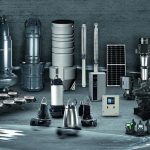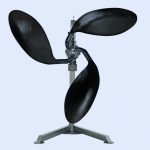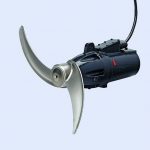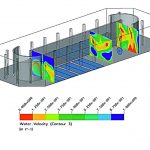Although the production-specific water requirements of the chemical industry have decreased dramatically in recent decades, significant amounts of wastewater are still in need of treatment. Energy-efficient pumps, mixers and associated systems ensure optimal availability and reduce operating costs.
Mixing and stirring with a hydrodynamically optimised propeller
Keeps wastewater slurry in motion
Although the production-specific water requirements of the chemical industry have decreased dramatically in recent decades, significant amounts of wastewater are still in need of treatment. Energy-efficient pumps, mixers and associated systems ensure optimal availability and reduce operating costs.
How do businesses deal with the “wastewater treatment” cost factor? In addition to further optimising the production processes, they are increasingly resorting to wastewater recycling in order to reduce fresh water consumption and hence the costs for treating process water. The use of wastewater heat and the occasional recovery of recyclables in the wastewater are new trends in industrial water use, as reported by Dechema. New technologies are being developed to meet future requirements. Even more interesting for practitioners are the parameters with an influence on energy efficient water treatment technology:
- Operational and procedural measures such as optimal oxygen or DM content and reflux ratios or reducing pressure losses by controlling the aerator
- Expansion and optimisation of the automation and control technology, for example by using frequency converters or reducing the running times of mixers and fans by time control or operation/pause control
- Efficient units such as new blowers, aeration elements and pumps, which consume less energy per unit than the existing plants and fixtures
- The biological treatment stage is the most complex and cost-intensive process in a sewage treatment plant. Mixing, stirring and circulation processes play an important role here. The Grundfos portfolio includes AMD mixers (0.9 to 18.0 kW), AFG flowmakers (between 0.7 and 8.0 kW) and SRG recirculators for this purpose, all of which are distinguished by low energy consumption and high flexibility even in confined spaces.
Mixing and stirring
Horizontal mixers are used for mixing, in other words homogenising and suspending liquids of low-to-medium viscosity. The slowly rotating mixers ensure that the sludge is homogenised before it is pumped and drained or dried. The rapidly rotating horizontal flowmakers help to avoid deposits and improve the exchange of substances. They are intended for mixing, i.e. keeping large quantities of low-to-medium viscosity liquid in motion.
The modular recirculation pumps are based on the principles of both the mixers and the flowmakers; they convey activated sludge and return sludge at a high flow rate with low head (in nitrification and denitrification zones). Fully submerged, continuous operation is possible; intermittent operation is limited to a maximum of 20 activations per hour.
Streamlined geometry ensures efficiency
The functionally important component – the propeller – has two or three angled blades which are inclined in the direction of flow with a self-cleaning effect. The streamlined geometry ensures high hydrodynamic efficiency. Whereas the mixer propellers are made of stainless steel, the flowmaker propeller is manufactured from polyurethane resin and has profiled blades. To protect the activated sludge (bacteria, fungi and protozoa), these propellers are designed for a blade tip speed of less than 6 m/s.
A space-saving planetary gear is positioned between the motor and the propeller. The mixers feature one gear stage while the flowmakers have two. The waterproof plug prevents the ingress of moisture into the motor up to an immersion depth of 20 m. The cable inlet has a double elastomer rubber seal with a clamping ring. The factory-assembled cable is split up into six wire strands to allow star-delta starting.
The mixers and flowmakers are equipped with monitoring sensors as standard: three thermal switches (PTO with the mixers) or three thermistors (PTC with the flowmakers) measure the temperature in the motor windings; a built-in water-in-oil sensor in the gear housing identifies penetrating media (a type ALR-20/A-Ex relay is also required), therefore forming an early warning system.
CFD programs optimise assembly
Practical experience shows that the arrangement of mixers and flowmakers in the basin of the sewage treatment plant is vital for their operational efficiency and service life. Grundfos specialists have acquired years of know-how with computational fluid dynamics (CFD) software and advise the operator accordingly. With the help of CFD, all bottlenecks and turbulence zones or areas in the basin with particularly low or high flow rates can be indicated and appropriate countermeasures taken. Variable speed drives ensure a constant flow and a uniform load, so as not to overload the biological treatment stage. Electricity savings of up to fifty percent are possible if the recommendations proposed by Grundfos as part of an energy audit are implemented.
In addition to wastewater technology, applications for mixers and flowmakers also exist in biogas plants, agriculture and industry – indeed anywhere where homogenising processes play a role, such as pulp and paper, paints and coatings or chemicals.
Hall A6, Booth 239
www.cpp-net.com search: cpp0216grundfos
ISO standard for assessing efficiency
Facts & Figures
Facts & Figures
ISO standard for assessing efficiency
Mixers are hydraulic machines which transform electrical energy into kinetic flow energy. Measurements in open, turbulent systems are difficult to reproduce and are therefore not comparable. It has consequently been difficult in the past for planners and operators to compare the efficiency of different agitators.
In many cases, customers have simply compared the mechanical performance and price and then decided on the cheapest product based on this information. Planners have often demanded a specific minimum energy input in their tenders, i.e. a certain amount of energy is required per volume of liquid to be stirred. There has thus been little incentive to develop efficient and energy saving solutions for industry.
The ISO 21630 standard was developed as a joint initiative by European mixer and pump manufacturers. The implementation of this international standard makes it possible to compare mixer efficiencies. The central parameter for assessing efficiency is the ratio of the generated thrust to the applied electric power under defined measurement conditions. The ISO standard is supplemented by VDMA Standard Sheet 24656, which seeks to ensure that essential procedural, operational and plant-specific factors are considered in the planning, design and execution of flow formation mixers in the aeration tanks of sewage treatment plants.
Rainer Stierle
Rainer Stierle
Sales Director Water Industry,
Grundfos
Share:










